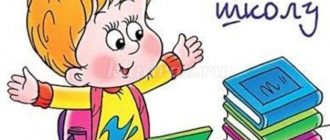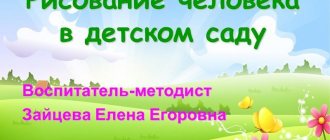Presentation “Russian heroes - epic heroes”
#Teaching and methodological materials #Presentation #All teachers #Educator #Intern student #Preschool education
“Russian heroes - epic writers” Educator: Shirkina V.L.
I’ll tell you about old deeds, Yes, about old things, about experienced ones, Yes, about battles, and about battles, Yes, about heroic deeds!
Bogatyrs Bogatyrs are epic images of heroes of ancient Slavic tribes. The heroes stood guard over Rus', at the outpost. Images of Russian heroes are widely reflected in the works of famous artists, for example, Mikhail Aleksandrovich Vrubel - the decorative panel “Bogatyr”, or Viktor Mikhailovich Vasnetsov - “Bogatyrs” (a painting that he painted for almost twenty years).
The meaning and origin of the word “hero” This word has several meanings: Hero of Russian epics and fairy tales. Defender of the homeland, a warrior distinguished by extraordinary strength, courage, and daring. Tall, well built, strong man. An extraordinary, outstanding person.
In ancient times, back in ancient Rus', very strong people - heroes - stood guard over the borders of our Motherland at the outpost. People composed songs and tales about them, which were called epics. These are the heroes depicted by the artist Vasnetsov in this painting (Vasnetsov’s painting “Bogatyrs” is included). Hero-heroes made the purpose of their lives to serve their Motherland - Rus'. When the heroes gathered together, as we see in Vasnetsov’s painting, they became so strong that it was impossible to defeat them. Bogatyrs have more or less common properties: strength and youth. Although epics often speak of the “old Cossack” Ilya Muromets, here the word old does not mean “burdened with years,” but only mature, experienced in military affairs. In ancient times, back in ancient Rus', very strong people - heroes - stood guard over the borders of our Motherland at the outpost. People composed songs and tales about them, which were called epics. These are the heroes depicted by the artist Vasnetsov in this painting (Vasnetsov’s painting “Bogatyrs” is included). Hero-heroes made the purpose of their lives to serve their Motherland - Rus'. When the heroes gathered together, as we see in Vasnetsov’s painting, they became so strong that it was impossible to defeat them. Bogatyrs have more or less common properties: strength and youth. Although epics often speak of the “old Cossack” Ilya Muromets, here the word old does not mean “burdened with years,” but only mature, experienced in military affairs.
Victor Vasnetsov “Bogatyrs on Horses.” 1896.
Behind the name of each of the epic heroes there is a specific person who lived once upon a time in Rus', and who accomplished his feats only in the epics their characters are embellished by the people. Behind the name of each of the epic heroes there is a specific person who lived once upon a time in Rus', and who accomplished his feats only in the epics their characters are embellished by the people. A storyteller walked from village to village and spoke in a sing-song voice (like a song) about heroic heroes and their exploits. He talked about how it happened. About the deeds and victories of the heroes, about how they defeated evil enemies, defended their land, showed their bravery, courage, ingenuity, and kindness.
Ilya Muromets Ilya Muromets is the most popular hero of epics, a mighty hero. The epic does not know him as a young man, he is an old man with a gray beard. Oddly enough, Ilya Muromets appeared later than his epic younger comrades Dobrynya Nikitich and Alyosha Popovich. His homeland is the city of Murom, the village of Karacharovo. The peasant son, the sick Ilya, “sat sitting on the stove for 30 years and three years.” One day, wanderers came to the house, “walking kaliki.” They healed Ilya, giving him heroic strength. From now on, he is a hero who is destined to serve the city of Kyiv and Prince Vladimir. On the way to Kyiv, Ilya defeats the Nightingale the Robber, puts him in a Toroki and takes him to the princely court. Among other exploits of Ilya, it is worth mentioning his victory over the Idolishch, which besieged Kyiv.
MONUMENT TO ILYA MUROMETS IN THE CITY OF MUROM The image of the ancient Russian hero embodied folk concepts of the high moral qualities that a true hero should have. One of the most important qualities of Ilya Muromets is a sense of justice and awareness of his duty - to stand for the truth. He is ready to go into direct conflict with the prince, with the boyars, when he sees that they are not doing the truth. He is a hero of the whole people, all-Russian, not bound by any class ties. “I am going to serve for the Christian faith and for the Russian land, and for the capital city of Kyiv-grad, for widows, for orphans, for poor people.”
Dobrynya Nikitich The most popular hero of the Russian epic after Ilya Muromets. He embodies those qualities that the people collectively denoted by the word “knowledge”: education, excellent upbringing, knowledge of etiquette, the ability to play the harp, intelligence (Dobrynya plays chess superbly). In addition to the listed qualities, he, like all heroes, is brave and courageous. Since childhood (from the age of 12 or 15), Dobrynya has mastered weapons.
Alyosha Popovich Alyosha Popovich, as the youngest, is the third in importance in the heroic trinity, along with Ilya Muromets and Dobrynya Nikitich. Alyosha Popovich is distinguished not by strength (sometimes his weakness is even emphasized, his lameness is pointed out, etc.), but by courage, daring, onslaught, on the one hand, and resourcefulness, sharpness, cunning, on the other. The birth of Alyosha Popovich was miraculous, reminiscent of the birth of Volkh: it is accompanied by thunder; “Alyoshenka the Wonderful Young,” as soon as he was born, asks his mother for a blessing to walk around the world, not to swaddle him in swaddling clothes, but in chain mail; he can already sit on a horse and wield it, operate with a spear and saber.
Victor Vasnetsov “Bogatyr” 1878. – Defend your homeland, take care of it. - Protect the weak, the poor, the elderly and children. - Be strong, brave, courageous, courageous. - To love your native land, your people, your country and your Motherland. The covenant of the heroes to us, their descendants:
Rostovsky Popovich
Georgy Yudin. Alyosha Popovich and Tugarin. Illustration for the epic. Year unknown
Boris Olshansky. Alyosha Popovich and Elena Krasa. 1996. Museum of Slavic Painting
Andrey Ryabushkin. Alesha Popovich. Illustration for the book “Russian epic heroes”. 1895
Alyosha Popovich was portrayed as the youngest of the heroes. The epics said that he was the son of a cathedral priest from Rostov (now a city in the Yaroslavl region). In different texts, two Rostov saints were called Alyosha's father - St. Leonty, whose relics are in the Rostov Assumption Cathedral, or Theodore, the first bishop of Rostov.
Despite his religious upbringing, Alyosha grew up as a joker and joker, and his courage always bordered on insolence. In some epics he was portrayed as a “woman’s mockingbird,” and in later texts he became a completely negative character. For example, it was sometimes told how Alyosha lied about Dobrynya’s death and deceived him into trying to marry his wife Nastasya. Dobrynya found out about this in time and managed to stop the wedding at the last moment. In the 20th century, research proved that initially Alyosha was not opposed to other heroes, but was the embodiment of truly popular qualities - passion, ingenuity and humor.
In the epic “Alyosha Popovich and Tugarin Zmeevich” the hero saw an enemy at the princely feast - Tugarin. Prince Vladimir the Red Sun greeted him as a dear guest, and Princess Eupraxia, in front of her husband, showed Tugarin unambiguous signs of attention. Alyosha began to mock this behavior, asking for a fight, and defeated Tugarin by cunning. Different versions describe how Popovich pretended to be hard of hearing so that Tugarin would get closer, or tricked his opponent into turning away, or struck while hiding behind the horse's mane. Alyosha jokingly offered Tugarin’s head to the prince as a dish:
You are here, Vladimir Stolnokievskaya! If you don’t have a beer cauldron now, - But those Tugarin’s violent heads; If the guys don’t have big bowls of beer, then those Tugarin’s are clear; If you don’t have big saucers, then those Tugarinovs will have big ears.
It is believed that the image of the hero Alyosha goes back to the real Rostov warrior Alexander Popovich, who died in 1223 in a battle with the Mongol-Tatars on the Kalka River. Academician Dmitry Likhachev attributed the first mention of Alexander Popovich in the chronicle to 1423, that is, 200 years after the hero’s supposed death. Likhachev established that it was not the hero who ended up in the epics from the chronicle, but, on the contrary, the chronicle recorded the character from the epic as a historical person. This was a conscious step of the chroniclers in the era of the formation of a centralized Russian state.
Folklorist Vladimir Propp believed that the image of Alyosha Popovich could have appeared soon after the baptism of Rus', because at that time the clergy were not yet perceived as a privileged class far from the common people. In a later era, the son of a priest could not have become in the eyes of the people a daring daredevil, mocking those in power, and remembering even his own priest father in jokes.
The same period - the 11th century - is indirectly indicated by the name of Alyosha’s rival, Tugarin Zmeevich. At that time, the Polovtsian Khan Tugarkan fought with Russia, and his daughter became the wife of the Kyiv prince Svyatopolk Izyaslavich. In the 11th–12th centuries, princes often entered into agreements with the Polovtsians and acted with them against other Russian principalities. The people condemned friendship with the enemy for the sake of fratricidal wars, and it was precisely this “friendship” that Alyosha put an end to by killing Tugarin.
Nikitich. A well-connected hero
0
Dobrynya Nikitich is often correlated with the chronicle Dobrynya, the uncle of Prince Vladimir (according to another version, nephew). His name personifies the essence of “heroic kindness.” Dobrynya has the nickname “young”, with enormous physical strength “he wouldn’t hurt a fly”, he is the protector of “widows and orphans, unfortunate wives.” Dobrynya is also “an artist at heart: a master of singing and playing the harp.”
×
Sukhman Odikhmantievich. Insulted hero
0
According to Vsevolod Miller, the prototype of the hero was the Pskov prince Dovmont, who ruled from 1266 to 1299. In the epic of the Kyiv cycle, Sukhman goes to get a white swan for Prince Vladimir, but on the way he comes into conflict with the Tatar horde, who are building Kalinov bridges on the Nepra River. Sukhman defeats the Tatars, but in the battle he receives wounds, which he covers with leaves. Returning to Kyiv without the white swan, he tells the prince about the battle, but the prince does not believe him and imprisons Sukhman in prison until clarification. Dobrynya goes to Nepra and finds out that Sukhman did not lie. But it's' too late. Sukhman feels disgraced, peels off the leaves and bleeds. The Sukhman River begins from his blood.
Duke Stepanovich. Bogatyr Major
0
Duke Stepanovich comes to Kiev from conventional India, behind which, according to folklorists, in this case the Galician-Volyn land is hidden, and organizes a marathon of boasting in Kyiv, undergoes tests from the prince, and continues to boast. As a result, Vladimir finds out that Duke is indeed very rich and offers him citizenship. But Duke refuses, because “if you sell Kyiv and Chernigov and buy paper for an inventory of Dyukov’s wealth, there won’t be enough paper.”
Nikita Kozhemyaka. Wyrm Fighter
0
Nikita Kozhemyaka in Russian fairy tales is one of the main snake-fighting characters. Before entering into battle with the Serpent, he tears 12 skins, thereby proving his legendary strength. Kozhemyaka not only defeats the Snake, but also harnesses him to a plow and plows the land from Kyiv to the Black Sea. The defensive ramparts near Kiev got their name (Zmievs) precisely because of the actions of Nikita Kozhemyaka.
Ilya Muromets. Holy hero
0
See all photos in the gallery
Ilya Muromets is canonized by the Russian Orthodox Church; he is the main Russian hero. Ilya Muromets is the main character not only of Russian epics, but also, for example, of German epic poems of the 13th century. In them he is also called Ilya, he is also a hero, yearning for his homeland. Ilya Muromets also appears in the Scandinavian sagas, in them he is, no less, the blood brother of Prince Vladimir.
Bova Korolevich. Lubok hero
0
Bova Korolevich was the most popular hero among the people for a long time. Popular folk tales about the “precious hero” were published in hundreds of editions from the 18th to the 20th centuries. Pushkin wrote “The Tale of Tsar Saltan”, partially borrowing the plot and names of the heroes of the fairy tales about the Boy Korolevich, which his nanny read to him. Moreover, he even made sketches of the poem “Bova,” but death would prevent him from finishing the work. The prototype of this knight was the French knight Bovo de Anton from the famous chronicle poem Reali di Francia, written in the 14th century. In this respect, Bova is a completely unique hero - a visiting hero.
Svyatogor. Mega-hero
0
Mega-hero. But a hero of the “old world.” The giant, the elder hero the size of a mountain, whom even the earth cannot support, lies on the mountain in inaction. The epics tell of his meeting with earthly cravings and death in a magical grave. Many features of the biblical hero Samson were transferred to Svyatogor. It is difficult to determine exactly its ancient origins. In the legends of the people, the veteran hero transfers his strength to Ilya Muromets, the hero of the Christian century.
Mikhailo Potyk. Faithful husband
0
Folklorists disagree on who should be associated with Mikhailo Potyk (or Potok). The roots of his image are found in the Bulgarian heroic epic, and in Western European fairy tales, and even in the Mongolian epic “Geser”. According to one of the epics, Potok and his wife Avdotya Swan Belaya make a vow that whichever of them dies first, the second one will be buried alive next to him in the grave. When Avdotya dies, Potok is buried nearby in full armor and on horseback, he fights the dragon and revives his wife with its blood. When he himself dies, Avdotya is buried with him.







